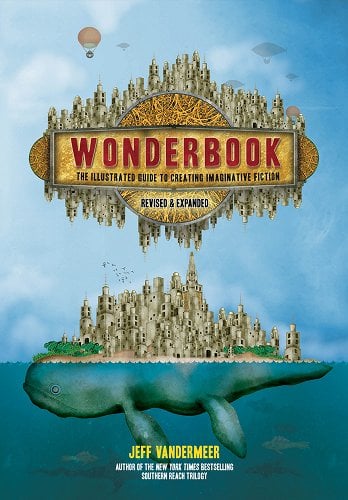Jeff Vandermeer’s Wonderbook and His Style Scale
A recent discussion in one of my book clubs (it’s a closed one, but you can always join me at my Doorstoppers Epic Reads book club over on Fable) got me thinking about different writing styles. In this post I revisit Jeff VanderMeer’s Wonderbook, and the style scale he provides there.
Cozy Food Mystery…or Witch Lit
It’s always interesting to hear others’ thoughts about the different books we read, and I’m always curious to know what it is that makes a book work for a reader, and what doesn’t. Some things are obvious, like bad writing. Even there I’m amazed at the high tolerance some readers have for low levels of writing. Aside from bad writing, there’s also books that are just not our cup of tea in terms of genre. Maybe you prefer a cozy food mystery (Fatal Fudge Swirl, by Meri Allen) to one with graphic depictions of violence (The Snowman, by Jo Nesbo). By the way, I just pulled that first title out of a hat. I’m always astonished at the number of books in this genre, but I don’t usually read them. Or perhaps your idea of a fun read is witch lit, either the cozy type or something more hardcore. You might not even know what cozy food mysteries or witch lit are.
What Keeps Us Reading (or Not)?
After we eliminate books that don’t do it for us in terms of genre, what is it about those we think we’ll like that keeps us reading? Conversely, what convinces us to quit and move on to the next book on our TBR? While it might be easy to ditch a book because of objectively bad writing, what about books that we can agree on are written well (or at least well enough)? What is it about them that may or may not work for us? A typical complaint is that a book was “too slow” or “nothing happened.” Another big one is not enough character development (“superficial read,” “generic characters”). Those are big factors in what does or doesn’t hit for us as readers (and writers).
One of the biggest hurdles for authors and readers to overcome, though, is being in agreement as to writing style, regardless of the style utilized. If there’s a match between the writer’s and reader’s styles, all’s well. On the other hand, a mismatch in terms of preferred style usually leads the reader to give up on a book. How often do you think about the style of the book you’re reading? Can you describe it in a useful or meaningful way?
Indescribably Fantastic Craft Book
Thinking about different styles reminded me of something I read several years ago in the indescribably fantastic craft book by Jeff VanderMeer, Wonderbook: The Illustrated Guide to Creating Imaginative Fiction. Do NOT be put off by the title. This book is loaded with so may beautiful illustrations, craft ideas, and interviews with other authors that it is worth its weight in gold, no matter what type of writing you do. An injection of imagination will do nothing but help you, so if you don’t have this book, I suggest you run to find an actual, physical copy. This book leaves me speechless every time I open it.
Stark to Ornate Style Scale
Along with all the other useful information, VanderMeer provides an extremely useful scale which divides styles into categories ranging from stark to ornate. In order, from most minimal to most lush, these are: Minimal/Stark, Invisible/“Normal,” Muscular/Conspicuous, and Lush/Ornate (p. 63). Although he provides several examples of authors who utilize each of these writing styles, I thought I would take a stab at providing examples of my own, using books and authors I actually know (I wasn’t familiar with all of the examples VanderMeer listed). As you read, think about which of the styles resonates with you the most. Then, what I think might be even more useful, think about those that you don’t like. For the record, all four of the authors listed below are extremely skilled writers. I enjoyed all of these books tremendously, but Black Leopard, Red Wolf was the hardest for me to get through (and understand, which is on me, not the author).
Minimal/Stark
Just as the name suggests, a Minimal/Stark style doesn’t include a lot of description and uses a lean approach to the prose. As VanderMeer states, “Poor execution leaves no purchase for the reader and induces boredom and sometimes contempt. Characterization relies in part on what’s not said, or not expressed.” (p. 63) Inducing contempt in a reader is definitely not what we’re aiming for, regardless of your writing style.
Here’s an example from The Tie That Binds, by Kent Haruf, where Sanders Roscoe, 24 years old at the time, has a conversation with his mother. The tension between the two of them is obvious from what is said, and what isn’t. The style, I think, reflects the setting of the story itself, which takes place in the eastern plains of Colorado.
Then in the spring of 1952 we had another fight. It was one evening during supper, after steak and potatoes but before the dessert, that my mother dropped some news on me, an announcement she wanted to make. She said she preferred that I hear it from her before someone else had the chance to tell me and get it all wrong. ‘I’m thinking of marrying again,’ she said. I took a drink of coffee and lit a cigarette. ‘Okay,’ I said. ‘Do whatever you want.’ ‘I intend to. But I wanted to discuss it with you first. It will mean some changes in both our lives.’ ‘Not in mine,’ I said. ‘I’m not marrying him.’ ‘Now that’s precisely what I was afraid of. Must you always be so pig-headed? You make me tired.’ ‘I said for you to do what you wanted. Isn’t that enough?’ She got up and cut two wedges of hot apple pie and scooped ice cream onto them and brought them to the table. I started to eat mine. ‘You haven’t asked me who he is. Don’t you care who I marry?’ ‘I figured you would tell me.’ (pp. 139-40)
Invisible/“Normal”
The second category VanderMeer talks about is Invisible/“Normal”. I like that Vandermeer puts “Normal” in quotation marks. It would be interesting to have all the authors VanderMeer mentions on his style scale in a room to find out what they think of the “Normal” idea, especially the ones he has listed in this section. Sadly, several of the authors on his style scale, including Kent Haruf, have passed away. Characteristics of the Invisible/“Normal” style include: “judicious use of sensory detail. Immersive reading is usually the goal. Few long sentences. Poor execution induces a reaction of ‘mediocrity.’” (p. 62) Ouch. When mediocrity strikes, we know it, even when we can’t put our finger on why. The same goes for a story that works for us. We might not know why, but we can feel it.
Here’s an example from The Good House, by Tananarive Due, a story I’m currently reading and enjoying greatly. Rick Leahy, an acquaintance of Angela, the main character, has ridden his horse onto the land where her grandmother’s house stands. The land and house have been left empty for a time due to a tragic event that happened during a Fourth of July party Angela hosted there. Rick notices something isn’t quite right:
At first, the scraping sound he heard in the leaves behind him sounded like the noise a small animal’s hurried passage might have made. A rabbit, a squirrel, maybe a creature as large as a fawn. The sound startled him because it was so close – ten yards, maybe fifteen – but he didn’t see any movement. Chestnut, sensing the shift of his mood, stirred with a snort, taking tentative steps forward and then backward, as much as her tied reins would allow. “Easy, girl,” Rick told her, really talking to himself. The sound came again, a little louder this time, though not as close, and from the opposite direction. Rick’s head whirled around. Nothing but the forest ahead of him, where it grew more densely, away from any clearings, gardens or beaten paths. Where very little sunlight bled through. A man might have made that sound. Or something bigger. (p. 83)
Muscular/Conspicuous
The third category on VanderMeer’s scale is Muscular/Conspicuous. Part of his description says that this writing style contains “ample use of extended metaphor and sensory detail. Poor execution induces a reaction of ‘too clever’ or ‘lost the thread.’” (p. 62) Aside from poor execution of this style, I imagine that some readers have this feeling of things being “too clever” just because the writing is more complex, often uses a wider vocabulary, and can possibly come across as snobbish. I remember reading a comment recently where a reader complained about how an author had described the sunset in flowery language that used the word “tangerine.” She wanted to know why the writer didn’t just say “the sky was orange.” Clearly a case of mismatched styles. I enjoy this style of writing a great deal, but it might be that people who spend the majority of their time reading books written in easier-to-digest styles just aren’t used to a richer style and it can get on their nerves.
Here’s an example from The Witch Elm, by Tana French. At the start of the story, the main character, Toby, reflects on events leading up to the mystery of the witch elm, a gigantic tree in his Uncle Hugo’s backyard. Here, Toby is setting up the long flashback that is the book, and he mentions two of the other big players in the story, his cousins, Susanna and Leon.
“That night. I know there are an infinite number of places to begin any story, and I’m well aware that everyone else involved in this one would take issue with my choice – I can just see the wry lift at the corner of Susanna’s mouth, hear Leon’s snort of pure derision. But I can’t help it: for me it all goes back to that night, the dark corroded hinge between before and after, the slipped-in sheet of trick glass that tins everything on one side in its own murky colors and leaves everything on the other luminous, achingly close, untouched and untouchable. Even though it’s demonstrably nonsense – the skull had already been tucked away in its cranny for years by that point, after all, and I think it's pretty clear that it would have resurfaced that summer regardless – I can’t help believing, at some level deeper than logic, that none of this would ever have happened without that night.” (p. 14)
You can see a big shift in style, I think, from the second to the third categories. The sentences are longer, more complex, and there’s more interiority. How do you like it compared to the first two styles? It definitely takes more focus and effort to read. A quick aside: I devoured the audiobook, which is narrated fantastically by author and voiceover artist Paul Nugent. Gotta love an Irish accent!
Lush/Ornate
VanderMeer’s final category is Lush/Ornate. According to him, in this style “the paragraphs exist to advance story and showcase words” and “poetic meter may be present.” (p. 62) I think a key point to remember here is what he says about the work “showcasing words.” This, in my opinion, is the category that tends to be the most difficult to get into, the most difficult to stick with, and the slowest to read.
Here’s what I think qualifies as an example, taken from Marlon James’s Black Leopard, Red Wolf:
“And I sunk, and I sunk, and the fire was cooling in my head, and people kept coming in and out, and whispering to me and shouting at me, like they were all ancestors come to gather on the branches of the great tree in the front yard. But my head wouldn’t settle. Something boomed, boomed again and then a memory or a daydream screamed, and then shouted, and slammed against my skull. The slam woke me up to see that I was not asleep. Something slammed against the door and fell to the ground. And then the boom hit like a bam and pushed a knuckle mark in the door as if somebody had punched dough.” (p. 454)
As you make your way down the scale (or up, depending on your point of view), the examples, in general, become more difficult to read; the pace (of both the storytelling and your reading) slows down. It can feel like more of an effort. This combination of change in style with increased reading effort is usually what causes someone to say they didn’t like a book. Maybe it’s not the story itself, but the way it’s told. A reader finds things tedious or just too much of an effort for the story, which in itself may be quite simple. This causes attention to wane, the reader loses interest, sets the book down, and maybe never goes back to it.
Which styles do you like most? Which authors do you read and where would you place them on VanderMeer’s scale? Do you find yourself stuck in a style rut? When it comes to reading and writing, I believe you should go with the things you like. Sometimes it’s good to mix things up as a reader, though. By the same token, as a writer you have to keep in mind that you have to tell a story that readers are going to want to read. For all that, when it comes time to put pen to paper, I’m not sure how much control we have over our own writing styles. I have a feeling the words just come out the way they do, developing over time, of course, but I’m not sure how much a writer can willingly change style in terms of moving up or down VanderMeer’s scale.
The Best Dialogue I’ve Heard Recently
Speaking of stories that you want to read or, in this case, watch, those of you who are subscribed to my newsletter know that recently I’ve been watching quite a few movies from the Eighties. I know, I know, I’m stuck in an Eighties loop of some kind — I’m fully under the Eighties nostalgia spell and contendedly so. One of the movies I watched last month has some of the best dialogue I’ve heard recently. I mean, how often do you hit rewind several times just to get it right?
Sharky’s Machine
This particular snippet comes from Sharky’s Machine, a 1981 neo-noir starring Burt Reynolds, based on William Diehl’s novel of the same name. Long, long before Travis Kelce was even born, Burt Reynolds had the original ‘stache and wore it well (although personally I think this style should stay in the Eighties and not make a comeback). And long, long before The Thorn Birds, Rachel Ward starred as Dominoe in this, her second movie.
Demoted to the Basement…and a Cesspool
The rest of the cast is wonderful, too, with faces you’ll probably recognize if you’re above a certain age. These are all guys who have played cops before and who are masterful at doing so. Sharky (Burt Reynolds) has screwed up on a bust and is demoted to the basement, where Vice is housed. His boss, Frisco (Charles Durning), delivers this, um, morsel, when he warns Sharky to toe the line in his new assignment:
“Down here, you don’t make waves. You’re right. This place is a cesspool, and if you make waves, I get a mouthful.”
Gotta love it! Between that and Sharky trying to protect Dominoe, all while she insists “I’m a dancer, not a prostitute!” it’s just an Eighties mudbath. You won’t realize what’s happening in the Peachtree Plaza Hotel in downtown Atlanta until it’s too late, just like Sharky.
Books Cited
Due, Tananarive. The Good House. New York: Atria Books, an imprint of Simon & Schuster (New York), 2003.
French, Tana. The Witch Elm. New York: Penguin, 2018. First published in the United States in 2018 by Viking, an imprint of Penguin Random House (New York).
Haruf, Kent. The Tie That Binds. New York: Vintage Books, 2000. First published 1984 by Holt, Rinehart and Winston (New York).
James, Marlon. Black Leopard, Red Wolf. New York: Riverhead Books, 2020. First published 2019 by Riverhead Books (New York).
VanderMeer, Jeff. Wonderbook: The Illustrated Guide to Creating Imaginative Fiction, Revised & Expanded. New York: Abrams Image, 2018. First published 2013 by Abrams Image (New York).
Pulling at Threads is my occasional newsletter. It always accompanies my blog posts but I sometimes send infrequent updates on other goings on. If you want more of an “insider’s” view on what’s happening in my reading and writing life, you can sign up here.


